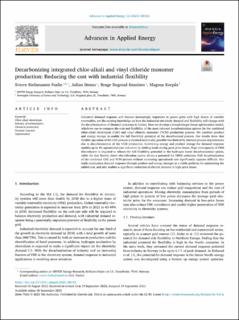| dc.contributor.author | Foslie, Sverre Stefanussen | |
| dc.contributor.author | Straus, Julian | |
| dc.contributor.author | Knudsen, Brage Rugstad | |
| dc.contributor.author | Korpås, Magnus | |
| dc.date.accessioned | 2024-01-15T11:11:00Z | |
| dc.date.available | 2024-01-15T11:11:00Z | |
| dc.date.created | 2023-09-26T10:17:40Z | |
| dc.date.issued | 2023 | |
| dc.identifier.issn | 2666-7924 | |
| dc.identifier.uri | https://hdl.handle.net/11250/3111499 | |
| dc.description.abstract | Industrial demand response will become increasingly important in power grids with high shares of variable renewables, yet the existing knowledge on how the industrial electricity demand and flexibility will change with the decarbonization of chemical processes is limited. Here we develop a mixed-integer linear optimization model, which we use to compare the cost and flexibility of the most relevant decarbonization options for the combined chlor-alkali electrolysis (CAE) and vinyl chloride monomer (VCM) production process. We combine product and energy storage to enable the full flexibility potential of the decarbonized process. Our results show that flexible operation of the CAE process is deemed technically possible but limited by internal process dependencies due to decarbonization of the VCM production. Combining energy and product storage for demand response enables up to 4% operational cost reduction by shifting loads during peak price hours. High overcapacity of PEM electrolyzers are required to release the full flexibility potential in the hydrogen based decarbonization option, while the less flexible direct electrification option shows a potential for OPEX reduction. Full decarbonization of the combined CAE and VCM process without increasing operational cost significantly appears difficult. Our study emphasizes demand response through product and energy storages as a viable pathway for minimizing the added cost, and also enables a significant reduction of electric demand in high-price hours. © 2023 The Author(s). Published by Elsevier Ltd. | en_US |
| dc.description.abstract | Decarbonizing integrated chlor-alkali and vinyl chloride monomer production: Reducing the cost with industrial flexibility | en_US |
| dc.language.iso | eng | en_US |
| dc.publisher | Elsevier | en_US |
| dc.rights | Navngivelse 4.0 Internasjonal | * |
| dc.rights.uri | http://creativecommons.org/licenses/by/4.0/deed.no | * |
| dc.title | Decarbonizing integrated chlor-alkali and vinyl chloride monomer production: Reducing the cost with industrial flexibility | en_US |
| dc.title.alternative | Decarbonizing integrated chlor-alkali and vinyl chloride monomer production: Reducing the cost with industrial flexibility | en_US |
| dc.type | Peer reviewed | en_US |
| dc.type | Journal article | en_US |
| dc.description.version | publishedVersion | en_US |
| dc.rights.holder | The Authors | en_US |
| dc.source.volume | 12 | en_US |
| dc.source.journal | Advances in Applied Energy | en_US |
| dc.identifier.doi | 10.1016/j.adapen.2023.100152 | |
| dc.identifier.cristin | 2178859 | |
| dc.relation.project | Norges forskningsråd: 257626 | en_US |
| dc.relation.project | Norges forskningsråd: 323330 | en_US |
| dc.relation.project | Norges forskningsråd: 257632 | en_US |
| dc.source.articlenumber | 100152 | en_US |
| cristin.ispublished | true | |
| cristin.fulltext | original | |
| cristin.qualitycode | 1 | |

